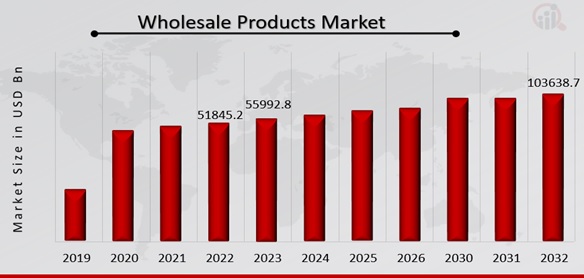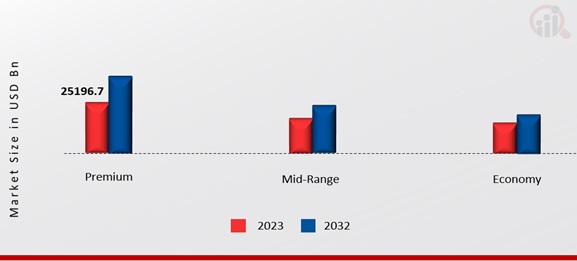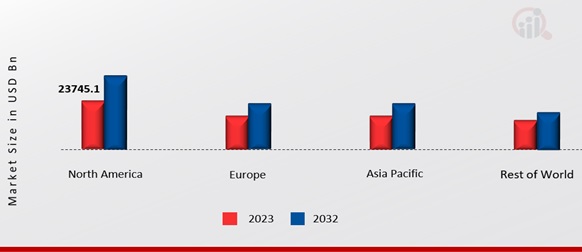Global Wholesale Products Market Overview
Wholesale Products Market Size was valued at USD 51845.2 Billion in 2022. The Wholesale Products market industry is projected to grow from USD 55992.8 Billion in 2023 to USD 103638.7 Billion by 2032, exhibiting a compound annual growth rate (CAGR) of 8.00% during the forecast period (2024 - 2032). Growing technological advancements and rising demand for value-added services are the key market drivers enhancing the market growth.

Source: Secondary Research, Primary Research, MRFR Database and Analyst Review
Wholesale Products Market Trends
- Rising e-commerce dominance is driving market growth
Wholesalers can now reach a wider and more geographically scattered customer base thanks to e-commerce. Wholesalers can now access new markets and consumer segments through this extended market reach, which may be difficult to achieve through traditional distribution channels. E-commerce does away with the requirement for a physical storefront and lowers the distribution costs related to the upkeep of brick-and-mortar establishments. By passing these cost savings to customers, wholesalers can increase the marketability of their products. E-commerce systems facilitate the purchasing process, increasing the efficiency of transactions for retailers and wholesalers. Transactions are completed more quickly and accurately when inventory is managed, orders are processed automatically, and payment systems are used. Sophisticated inventory management systems are frequently included with e-commerce platforms, allowing wholesalers to monitor stock levels instantly. This lowers the possibility of stockouts, boosts order fulfillment, and increases the overall effectiveness of the supply chain. For illustration, the United States Census Bureau, a US-based government body, reported in August 2023 that retail sales increased by 0.6% (or 0.4%). Still, the estimate for e-commerce increased by 7.5% (or 1.4%) in the second quarter of 2023. Therefore, the wholesale market is expanding due to the growing popularity of e-commerce.
Additionally, digitization reduces errors and manual interventions by streamlining several supply chain operations. Wholesalers can handle higher volumes more easily thanks to automated systems for order processing, inventory management, and logistics, which result in faster and more efficient operations. Digital supply chain solutions offer real-time tracking of shipments, order status, and inventory levels. Because of this transparency, wholesalers can react swiftly to shifts in demand, plan for possible supply chain interruptions, and make well-informed decisions. With the help of digital solutions that offer precise demand forecasting and inventory tracking, wholesalers may optimize inventory levels. This lowers holding costs, reduces overstock and stockouts, and guarantees that supplies are available when and where they are needed.
Wholesalers can earn a higher profit margin by eliminating intermediaries from the retail chain. Wholesalers can determine their pricing and forego the markups that retailers usually impose by selling directly to customers. Greater control over brand image and messaging is afforded to wholesalers through direct-to-consumer (D2C) strategies. Wholesalers may create a more individualized relationship with customers, foster brand loyalty, and manage the story surrounding their products by interacting directly with them. Thus, driving the Wholesale Products market revenue.
Wholesale Products Market Segment Insights
Wholesale Products Type Insights
Based on Type, the Wholesale Products market segmentation includes non-durable goods wholesalers, wholesale electronic markets and agents and brokers, and durable goods wholesalers. In 2023, the non-durable goods wholesalers segment dominated the market. This is because food, drink, toiletries, clothes, and other non-durable goods are examples of essentials that people frequently buy. Consumer purchasing habits, which are impacted by the state of the economy, job levels, and disposable income, are directly linked to the demand for these products.
The durable goods wholesaler category is anticipated to be the fastest growing. Appliances and other durable products are frequently associated with the home market. Developments in the real estate, building, and remodeling industries may impact the need for durable goods distributors. A strong housing market may increase demand for appliances and furniture.
Wholesale Products Ownership Insights
Based on ownership, the Wholesale Products market segmentation includes wholesale/distribution chain and independent wholesalers. The wholesale/distribution chain category leads the market. Large corporations own and run some wholesale and distribution channels. Corporate ownership may result in standardized procedures, economies of scale, and centralized decision-making. A company's ability to negotiate favorable terms with suppliers, the effectiveness of the supply chain, and corporate strategy can all impact demand.
During the projection period, the wholesale products market’s independent wholesalers segment is anticipated to grow fastest. Independent wholesalers frequently have more latitude in decision-making than larger corporate entities. The ownership's entrepreneurial spirit may influence a product's demand, enabling quicker reactions to market shifts, consumer preferences, and developing trends.
Wholesale Products Price Range Insights
Based on Price Range, the Wholesale Products market segmentation includes premium, mid-range, and economy. The premium category leads the market. Expensive goods are sometimes linked to luxury labels or designers. Wholesalers in this market could work with well-known brands or select collections from designers famous for their originality, flair, and imagination.
The mid-range segment of the wholesale products market is predicted to develop at the quickest rate over the projected period. Mid-range wholesalers must continue to offer competitive prices. The items' value proposition should be reflected in the price strategy, which offers affordability without significantly compromising quality.
Figure 1: Wholesale Products Market, by Price Range, 2023 & 2032 (USD Billion)

Source: Secondary Research, Primary Research, MRFR Database and Analyst Review
Wholesale Products Regional Insights
By region, the study provides market insights into North America, Europe, Asia-Pacific, and the Rest of the World. The North American wholesale products market area will dominate this market, owing to the economies of North America, which includes the US and Canada, are strong and developed. Because firms in the region have the financial capacity for significant transactions and investments, the region's economic strength creates an atmosphere favorable for wholesale trade. A sizable, diversified consumer base with substantial purchasing power distinguishes the North American market. Wholesalers have the chance to meet a variety of tastes and profit from various market niches due to the demand for a broad range of items.
Further, the major countries studied in the market report are the US, Canada, Germany, France, the UK, Italy, Spain, China, Japan, India, Australia, and South Korea.
Figure 2: Wholesale Products Market Share BY REGION 2023 (USD Billion)

Source: Secondary Research, Primary Research, MRFR Database and Analyst Review
Europe's Wholesale Products market accounts for the second-largest market share due to European countries' highly established infrastructure and logistics networks. Effective supply chain, communication, and transportation systems make the smooth flow of commodities possible, raising wholesale distribution's overall effectiveness. Further, the German Wholesale Products market held the largest market share, and the UK Wholesale Products market was the fastest-growing market in the European region.
The Asia-Pacific Wholesale Products Market is expected to grow at the fastest CAGR from 2024 to 2032. Asia Pacific is home to a large and varied customer base. There are plenty of chances for wholesalers due to the increased demand for a wide range of items from the developing middle class, increasing urbanization, and growing disposable incomes. Moreover, China’s Wholesale Products market held the largest market share, and the Indian Wholesale Products market was the fastest-growing market in the Asia-Pacific region.
Wholesale Products Key Market Players & Competitive Insights
The Wholesale Products market will continue to grow due to major companies in the industry making significant R&D investments to extend their Type ranges. Significant market developments include new Type releases, contractual agreements, mergers and acquisitions, greater investments, and cooperation with other organizations. Market participants also engage in various strategic actions to broaden their footprint. The Wholesale Products sector must provide affordable Types to grow and thrive in a more cutthroat and dynamic market.
One of the main strategies manufacturers use in the worldwide Wholesale Products market to benefit customers and expand the market sector is local manufacturing to reduce operating expenses. Some of the biggest benefits of medicine in recent years have come from the Wholesale Products sector. Major players in the Wholesale Products market, including Walmart Inc., Amazon.com Inc., Cardinal Health Inc., The Home Depot Inc., Berkshire Hathaway Inc., AmerisourceBergen Corp., Target Corporation, Sinopharm, Itochu Corp, Lowe's Companies Inc., Sysco Corp., Best Buy Co. Inc., Dollar General Corporation, Tech Data Corp., The Sherwin-Williams Company, Genuine Parts Company, C&S Wholesale Grocers Inc., Dollar Tree Inc., BJ's Wholesale Club Holdings Inc., and others, are attempting to increase market demand by investing in research and development operations.
Grocery stores, supermarkets, hypermarkets, department and discount stores, and local markets are all operated by Walmart Inc. (Walmart). Grocery and consumables, health and wellness, technology, office and entertainment, hardlines, clothing, and home categories are all available at the company's stores at consistently cheap costs. Sam's Clubs and other warehouse clubs are run by it as well. Walmart offers merchandise under several licensed brands and private labels, such as Equate, Mainstays, George, Onn, Parent's Choice, Time and Tru, Wonder Nation, and No Boundaries. Along with associated goods, including money orders, prepaid cards, money transfers, check cashing, and bill payments, the company also sells fuel, gift cards, and financial services.
Amazon.com Inc. is an e-commerce company that also offers web services. The company offers a variety of things, including clothing, toys, sports goods, toys for kids and babies, electronics, groceries, games, jewelry, auto and industrial supplies, beauty and wellness products, and gadgets. In addition, it provides associated support services like shipping and home delivery, cloud web hosting, and other web-related services. Amazon sells its goods using channels that it owns, both online and offline. Additionally, it produces and sells various electronic products, including TVs, tablets, Kindle e-readers, Echo, Alexa, and other gadgets. The company can publish and sell content from writers, singers, filmmakers, and creators.
Key Companies in the Wholesale Products Market Include
- Walmart Inc.
- com Inc.
- Cardinal Health Inc.
- The Home Depot Inc.
- Berkshire Hathaway Inc.
- AmerisourceBergen Corp.
- Target Corporation
- Sinopharm
- Itochu Corp
- Lowe's Companies Inc.
- Sysco Corp.
- Best Buy Co. Inc.
- Dollar General Corporation
- Tech Data Corp.
- The Sherwin-Williams Company
- Genuine Parts Company
- C&S Wholesale Grocers Inc.
- Dollar Tree Inc.
- BJ's Wholesale Club Holdings Inc.
Wholesale Products Industry Developments
March 2023: Dash is a new digital solution introduced by the Dutch accounting and services network KPMG International Limited to improve retail services. Due to Dash's rapid startup, KPMG used automation to make it available to many organizations. Dash doesn't require development or implementation time, and there are no upfront costs.
Wholesale Products Market Segmentation
Wholesale Products Type Outlook
- Non-Durable Goods Wholesalers
- Wholesale Electronic Markets and Agents and Brokers
- Durable Goods Wholesalers
Wholesale Products Ownership Outlook
- Wholesale/Distribution Chain
- Independent Wholesalers
Wholesale Products Price Range Outlook
- Premium
- Mid-Range
- Economy
Wholesale Products Regional Outlook
- North America
- Europe
- Germany
- France
- UK
- Italy
- Spain
- Rest of Europe
- Asia-Pacific
- China
- Japan
- India
- Australia
- South Korea
- Australia
- Rest of Asia-Pacific
- Rest of the World
- Middle East
- Africa
- Latin America
| Report Attribute/Metric |
Details |
| Market Size 2022 |
USD 51845.2 Billion |
| Market Size 2023 |
USD 55992.8 Billion |
| Market Size 2032 |
USD 103638.7 Billion |
| Compound Annual Growth Rate (CAGR) |
8.00% (2024-2032) |
| Base Year |
2023 |
| Market Forecast Period |
2024-2032 |
| Historical Data |
2019- 2021 |
| Market Forecast Units |
Value (USD Billion) |
| Report Coverage |
Revenue Forecast, Market Competitive Landscape, Growth Factors, and Trends |
| Segments Covered |
Type, Ownership, Price Range, and Region |
| Geographies Covered |
North America, Europe, Asia Pacific, and the Rest of the World |
| Countries Covered |
The US, Canada, Germany, France, UK, Italy, Spain, China, Japan, India, Australia, South Korea |
| Key Companies Profiled |
Walmart Inc., Amazon.com Inc., Cardinal Health Inc., The Home Depot Inc., Berkshire Hathaway Inc., AmerisourceBergen Corp., Target Corporation, Sinopharm, Itochu Corp, Lowe's Companies Inc., Sysco Corp., Best Buy Co. Inc., Dollar General Corporation, Tech Data Corp., The Sherwin-Williams Company, Genuine Parts Company, C&S Wholesale Grocers Inc., Dollar Tree Inc., and BJ's Wholesale Club Holdings Inc. |
| Key Market Opportunities |
The growing demand for sustainable and eco-friendly products and specialization in niche markets |
| Key Market Dynamics |
Growing advancements in technologies and rising demand for value-added services |
Frequently Asked Questions (FAQ) :
The Wholesale Products market size was valued at USD 55992.8 Billion in 2023.
The market is projected to grow at a CAGR of 8.00% during the forecast period, 2024-2032.
North America had the largest share of the market.
The key players in the market are Walmart Inc., Amazon.com Inc., Cardinal Health Inc., The Home Depot Inc., Berkshire Hathaway Inc., AmerisourceBergen Corp., Target Corporation, Sinopharm, Itochu Corp, Lowe's Companies Inc., Sysco Corp., Best Buy Co. Inc., Dollar General Corporation, Tech Data Corp., The Sherwin-Williams Company, Genuine Parts Company, C&S Wholesale Grocers Inc., Dollar Tree Inc., and BJ's Wholesale Club Holdings Inc, among others.
The Non-Durable Goods Wholesalers category dominated the market in 2023.
The Wholesale/Distribution Chain had the largest share in the market.





























